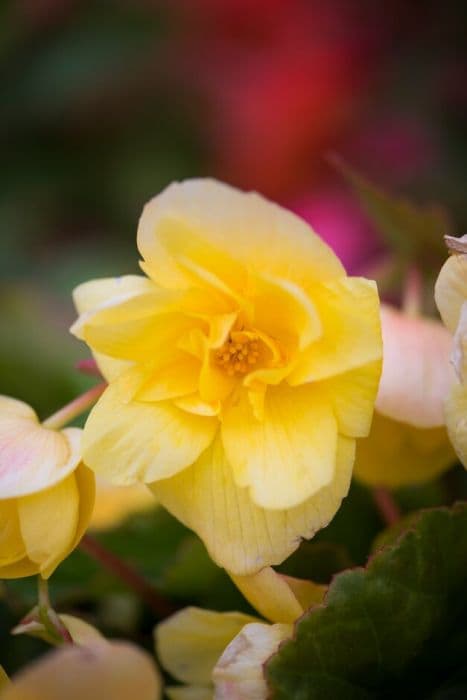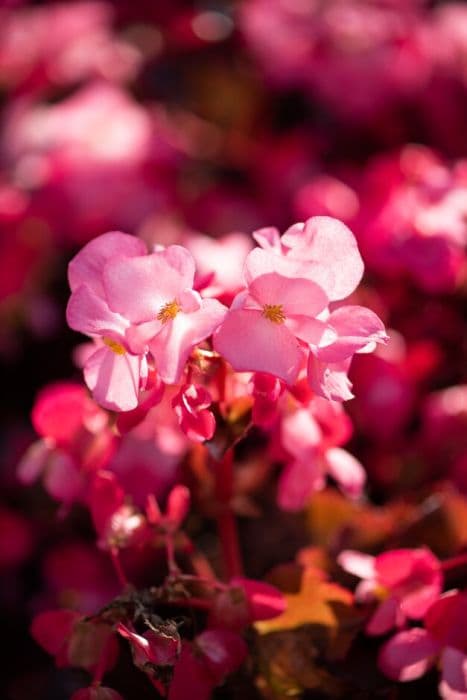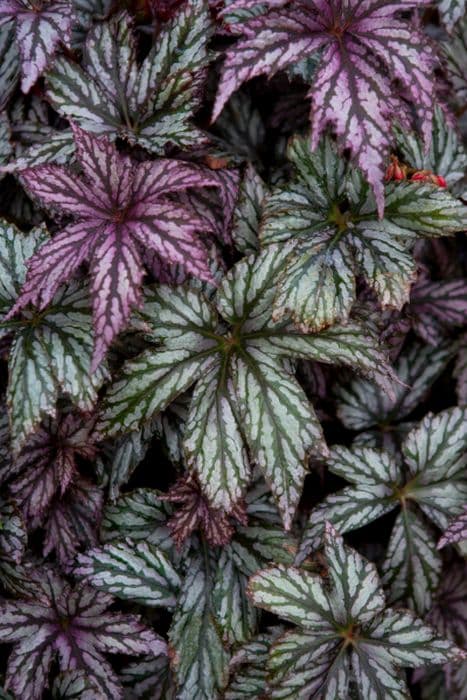Begonia Begonia Party Series (S)

ABOUT
The Begonia Party Series (S) features a lush, vibrant display of foliage and flowers that make it a popular choice for garden enthusiasts. The leaves are broad and come in a variety of colors, often with a mix of green, red, and silver shades, exhibiting a unique pattern that can include spots or intricate vein-like designs. The edges of the leaves are usually wavy or serrated, adding to their ornate appearance. The flowers of the Begonia Party Series (S) are equally showy and come in a range of colors such as pink, white, red, or orange. They typically have a delicate, layered look, with each flower composed of multiple petals that can be ruffled or smooth. These blossoms are known for their symmetrical form and sometimes have a slight sheen, giving the plant an overall festive and lively presence, as the series name suggests. The Begonia Party Series (S) tends to have a compact, bushy growth habit, which allows for a dense cluster of leaves and flowers to form. This characteristic contributes to its full and abundant appearance, making it an attractive option for both indoor containers and outdoor planting spaces. The combination of its attention-grabbing leaves and eye-catching flowers creates a stunning visual impact, ensuring that this plant lives up to its "party" reputation with a continuous celebration of colors and textures.
About this plant
 Names
NamesFamily
Begoniaceae
Synonyms
Party Series Begonia, Begonia 'Party Series'
Common names
Begonia Party Series (S).
 Toxicity
ToxicityTo humans
Begonias, including those from the Begonia Party Series, contain compounds that can be mildly toxic to humans if ingested. The most notable toxic elements are oxalate crystals, which can cause irritation to the mouth, throat, and gastrointestinal tract. If parts of the plant are eaten, symptoms may include a burning sensation in the mouth, difficulty in swallowing, nausea, vomiting, and diarrhea. Contact with the sap can also irritate the skin or eyes in sensitive individuals.
To pets
Begonias, such as those in the Begonia Party Series, are also toxic to pets. The main toxic component, soluble calcium oxalates, can cause similar symptoms in animals as in humans. If a pet ingests part of a begonia plant, it might exhibit signs like vomiting, salivation, oral pain, and difficulty swallowing. In severe cases, it can lead to kidney failure or other systemic issues, so it is important to prevent pets from chewing on or consuming any part of the plant and to seek veterinary attention if ingestion occurs.
 Characteristics
CharacteristicsLife cycle
Annuals
Foliage type
Deciduous
Color of leaves
Varies
Flower color
Varies
Height
1 foot (30 cm)
Spread
1 foot (30 cm)
Plant type
Herb
Hardiness zones
10
Native area
Tropical South America
Benefits
 General Benefits
General Benefits- Ornamental Value: Begonias are known for their attractive foliage and flowers, adding aesthetic appeal to gardens and living spaces.
- Versatility: They can be grown indoors as houseplants or outside in flower beds and containers, making them suitable for various gardening needs.
- Color Variety: The Begonia Party Series offers a range of colors, providing options to complement different design schemes and personal preferences.
- Low Maintenance: Begonias generally require minimal care, making them a great choice for gardeners of all skill levels.
- Drought Tolerant: They are somewhat tolerant to drought conditions once established, reducing the need for frequent watering.
- Non-Toxic: Generally, begonias are non-toxic to humans and pets, making them a safe addition to homes with children and animals.
- Long Flowering Season: With the proper care, Begonia Party Series plants can bloom for an extended period, enhancing garden displays with long-lasting color.
 Medical Properties
Medical PropertiesThis plant is not used for medical purposes.
 Air-purifying Qualities
Air-purifying QualitiesThis plant is not specifically known for air purifying qualities.
 Other Uses
Other Uses- Educational Tool: Begonia can be used in educational settings to teach students about plant biology, hybridization techniques, and the diversity of plant life.
- Photography Subjects: The vibrant colors and variety of forms make them excellent subjects for photography enthusiasts aiming to capture the beauty of nature.
- Artistic Inspiration: Artists may use Begonia as a muse for paintings, illustrations, or sculptures due to their diverse and striking appearance.
- Therapeutic Horticulture: Working with Begonia can serve as a form of horticultural therapy, providing emotional and mental benefits through the act of gardening.
- Eco-friendly Confetti: Dried Begonia petals can be used as a natural and biodegradable confetti alternative for celebrations.
- Floral Arrangements: Begonia flowers can be incorporated into floral arrangements to add a unique touch to bouquets or table centerpieces.
- Crafting Supplies: The foliage and flowers of Begonia can be used in crafting activities, such as making pressed flower bookmarks or homemade greeting cards.
- Table Decor: Small Begonia plants can be used as living table decorations for events, adding a splash of color and greenery.
- Cooking Garnish: Edible varieties of Begonia can be utilized as a colorful garnish for culinary dishes, adding both flavor and visual appeal.
- Natural Dye: The pigments in Begonia petals and leaves can potentially be used to create natural dyes for fabrics or art projects.
Interesting Facts
 Feng Shui
Feng ShuiThe Begonia is not used in Feng Shui practice.
 Zodiac Sign Compitability
Zodiac Sign CompitabilityThe Begonia is not used in astrology practice.
 Plant Symbolism
Plant Symbolism- Caution: Begonias are often associated with warnings to be careful or heed caution in situations.
- Uniqueness: The Begonia Party Series, with its distinctive and varied colors, can symbolize one's unique qualities and individuality.
- Deep Thinking: Begonias may represent introspection and deep thinking, inviting self-reflection and personal growth.
- Gratitude: Giving begonias is a way of expressing thanks or gratitude towards someone for their help or kindness.
- Harmony: The balanced growth and symmetry of the Begonia Party Series can symbolize harmony and a peaceful ambiance.
 Water
WaterBegonias, including the Party Series, prefer soil that is moist but not waterlogged. It's important to water them when the top inch of soil feels dry to the touch. Water the plant thoroughly until excess water drains out of the bottom, which may be about 16 ounces for a small pot every week, but this can vary depending on the size of the plant and environmental conditions. During active growth in spring and summer, they may need more frequent watering, but always check the soil moisture level first. Reduce watering in the cooler months when plant growth slows down.
 Light
LightBegonias such as the Party Series thrive in bright, indirect light. They do well in east or west-facing windows where they receive some morning or evening sun but are protected from the intense midday rays. Avoid placing them in full direct sunlight, which can scorch their leaves; a spot with filtered sunlight is ideal.
 Temperature
TemperatureThe Party Series Begonia enjoys warm temperatures ranging from 60 to 75 degrees Fahrenheit. They can tolerate a minimum temperature of around 50 degrees but should not be exposed to temperatures below this as they are sensitive to cold. The ideal temperature range facilitates healthy growth and flowering.
 Pruning
PruningPruning your Party Series Begonia is essential for encouraging bushier growth and removing any dead or yellowing leaves. Trim the plant as needed to maintain its shape, usually during the spring or early summer when new growth appears. Regularly check and prune the begonia every couple of months to keep it healthy and aesthetically pleasing.
 Cleaning
CleaningAs needed
 Soil
SoilBegonias prefer a well-draining soil mix consisting of peat moss, perlite, and vermiculite in equal parts. The ideal pH for Party Series Begonia should be slightly acidic to neutral, ranging from 5.5 to 7.
 Repotting
RepottingParty Series Begonias should be repotted once every 1-2 years or when they outgrow their current container. It's best to repot in spring.
 Humidity & Misting
Humidity & MistingParty Series Begonias thrive in moderate to high humidity levels, around 50-70%, but they can tolerate lower humidity if necessary.
 Suitable locations
Suitable locationsIndoor
Provide bright indirect light and high humidity for Begonias indoors.
Outdoor
Place in dappled shade with protection from harsh sun.
Hardiness zone
10-11 USDA
 Life cycle
Life cycleThe life of Begonia Party Series typically begins with seed germination, where the seeds need warmth and moisture to sprout. Seedlings emerge and begin to exhibit their first true leaves, initiating the vegetative growth phase characterized by leaves and stem development. As the plant matures, it enters the flowering stage, producing vibrant blooms that are the hallmark of the Party Series. After pollination, the flowers may produce seeds, completing the reproductive cycle. If conditions are less than ideal for seed production, the begonias can also reproduce vegetatively through cuttings or division of the tubers. As annuals or perennials depending on the climate, the plants will either die after the growing season or enter a period of dormancy before resuming growth the following season.
 Propogation
PropogationPropogation time
Spring to Summer
The Begonia Party Series (S), commonly referred to as Begonias, is typically propagated through stem cuttings. This popular method involves cutting a stem from the mature plant using a sharp, sterile knife or scissors, ensuring the cutting includes at least one node, which is where the leaf meets the stem. This node is where new roots will develop. The cutting is then placed in a well-draining potting mix or sometimes directly into water to encourage root growth. If placed in soil, the cutting should be kept in a warm, humid environment with bright, indirect light until roots have formed, which usually takes several weeks. For water propagation, once roots have appeared and reached about an inch long (approximately 2.54 cm), the cutting can be transferred to soil to continue growing.





![Begonia [Devotion]](/_next/image?url=https%3A%2F%2Fplants-admin.emdemapps.com%2Fimages%2Fplants%2F%2Fimages%2F604b58183573b.png&w=640&q=75)



